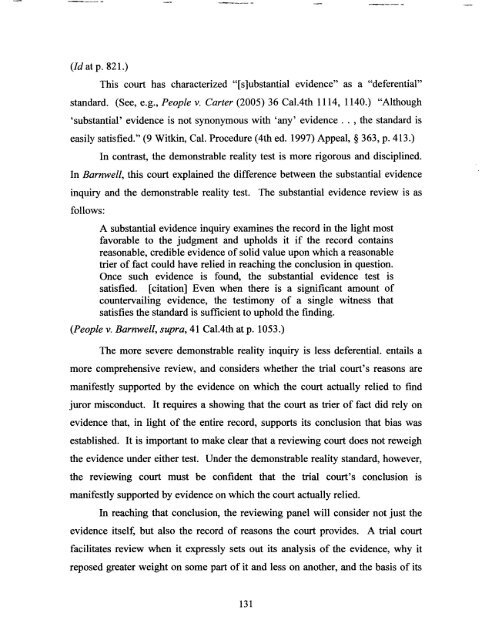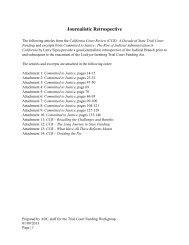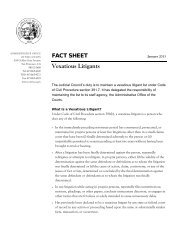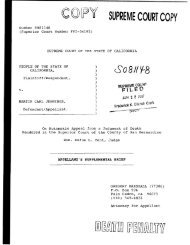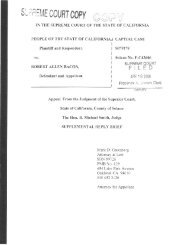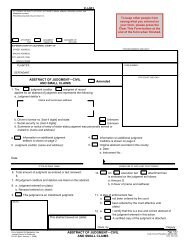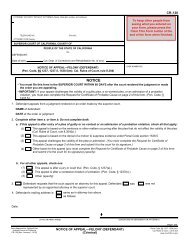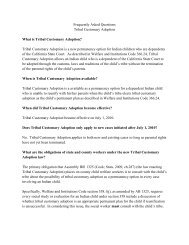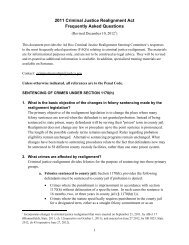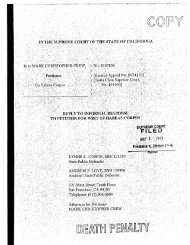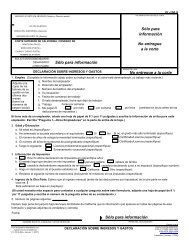Appellant, William Satele, Reply Brief - California Courts - State of ...
Appellant, William Satele, Reply Brief - California Courts - State of ...
Appellant, William Satele, Reply Brief - California Courts - State of ...
You also want an ePaper? Increase the reach of your titles
YUMPU automatically turns print PDFs into web optimized ePapers that Google loves.
(Id at p. 821.)<br />
This court has characterized "[s]ubstantial evidence" as a "deferential"<br />
standard. (See, e.g., People v. Carter (2005) 36 Cal.4th 1114, 1140.) "Although<br />
'substantial' evidence is not synonymous with 'any' evidence .. , the standard is<br />
easily satisfied." (9 Witkin, Cal. Procedure (4th ed. 1997) Appeal, § 363, p. 413.)<br />
In contrast, the demonstrable reality test is more rigorous and disciplined.<br />
In Barnwell, this court explained the difference between the substantial evidence<br />
inquiry and the demonstrable reality test. The substantial evidence review is as<br />
follows:<br />
A substantial evidence inquiry examines the record in the light most<br />
favorable to the judgment and upholds it if the record contains<br />
reasonable, credible evidence <strong>of</strong>solid value upon which a reasonable<br />
trier <strong>of</strong> fact could have relied in reaching the conclusion in question.<br />
Once such evidence is found, the substantial evidence test is<br />
satisfied. [citation] Even when there is a significant amount <strong>of</strong><br />
countervailing evidence, the testimony <strong>of</strong> a single witness that<br />
satisfies the standard is sufficient to uphold the finding.<br />
(People v. Barnwell, supra, 41 Cal.4th at p. 1053.)<br />
The more severe demonstrable reality inquiry is less deferential. entails a<br />
more comprehensive review, and considers whether the trial court's reasons are<br />
manifestly supported by the evidence on which the court actually relied to find<br />
juror misconduct. It requires a showing that the court as trier <strong>of</strong> fact did rely on<br />
evidence that, in light <strong>of</strong> the entire record, supports its conclusion that bias was<br />
established. It is important to make clear that a reviewing court does not reweigh<br />
the evidence under either test. Under the demonstrable reality standard, however,<br />
the reviewing court must be confident that the trial court's conclusion IS<br />
manifestly supported by evidence on which the court actually relied.<br />
In reaching that conclusion, the reviewing panel will consider not just the<br />
evidence itself, but also the record <strong>of</strong> reasons the court provides. A trial court<br />
facilitates review when it expressly sets out its analysis <strong>of</strong> the evidence, why it<br />
reposed greater weight on some part <strong>of</strong> it and less on another, and the basis <strong>of</strong> its<br />
131


